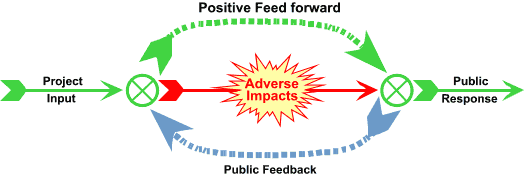Project Public Relations
Traditional management has long since recognized the classic Input-Process-Output
model with its management feedback loop for controlling output, see Figure
3. Dynamic managers also recognize that opening communication channels in
both directions constitutes a powerful motivator at the operative level. Whether
quality information is presented in verbal, written or graphical form, improvement
in performance can be quite remarkable. Indeed, many knowledge workers demand
it, and the Japanese have built their industrial reputation on the "quality
circle", which uses this principal.

Figure 3: Traditional management feedback
The principal is just as true in the field of projects, though regretfully
much less evident on construction projects. Nevertheless, on a major project,
especially if it is publicly funded, providing a general information center is
quite normal. A more proactive stance, or positive feed forward, is usually known
as Public Relations, or just PR, and plays a vital in the favorable influence
of the environment of a complex project. This public relations feed forward concept
is shown in Figure 4.

Figure 4: Public relations feed forward concept
To a surprisingly large extent, the project team's ability to exercise this
positive feed forward will determine their ability to control the project in
terms of its final cost and schedule.
The Public Relations Plan
Good public relations requires a strong identity, a planned program and concrete
goals, and commences with appointing someone to be responsible. That person must
be outgoing and positive, yet able and willing to listen. He or she must be capable
of preparing carefully constructed text and presentations, and be able to work
through a program systematically. Like every other major function of the project
management process, the PR function should be conducted like a sub-project.
In developing a PR plan, the following eight steps are recommended. It will
be noted that many of the recommendations made earlier are incorporated.
- Know the project organization and its objectives thoroughly
- Determine who the interested publics will be and the characteristics of each
- Establish the relative importance of each to the project, and in particular,
identify the "high risk" areas
- Assess the current reputation of the sponsoring organization as it is perceived
by each of the interested groups
- Determine appropriate action in each case
- Develop strategy, resource requirements, priorities and schedule which are
in sympathy with the project itself
- Implement the PR program
- Continuously monitor the effectiveness of the program during its execution,
and adjust as necessary for optimum results
Ensuring the Effectiveness of the PR Plan
What are the hallmarks of successful PR? Here is a top ten check list of a
good public relations program:
- Develop quality information about the benefits of the project
- Care and concern genuinely expressed for the project's stakeholders
- Timely (rapid) response provided to information requests
- Information requirements anticipated and provided ahead of time
- Genuinely sincere appreciation expressed to a stakeholder for their inquiry
- Flexible personal responses provided, where special issues dictate
- Recovery from inevitable lapses of services during implementation, in ways
that impress
- Project team members empowered to make decisions to solve urgent and obvious
problems
- Stakeholder-friendly policies and procedures established
- Stakeholder-friendly facilities available both during project implementation,
as well as subsequently
|



